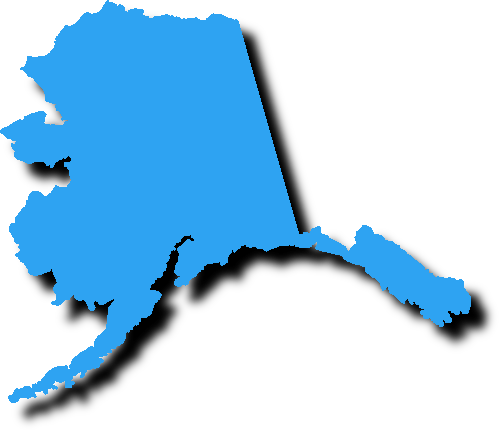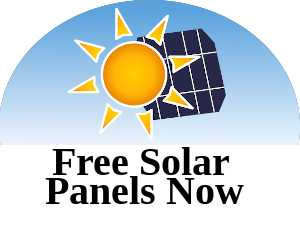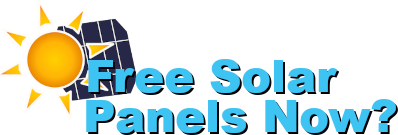Free Solar Panels In Alaska?
Being updated for 2024
Written By Rob T.
Solar power and alternative technology enthusiast
This page is being updated for 2024
Page Navigation
Can You Get Free Solar Panels In Alaska?
Unfortunately, no, you can’t get free solar panels in Alaska
There are companies that are advertising “Free Solar Panels” but what they really mean is that you can get solar panels installed for free. Meaning no upfront cost.
However as far as we know there are no programs at the Federal, State, or Local levels that will just give you free solar panels.

Alaska At A Glance
Choosing solar panels in Alaska can be a practical and environmentally conscious decision despite the state’s challenging weather conditions.
While Alaska experiences long winters with reduced sunlight, advancements in solar technology, such as improved panel efficiency and energy storage solutions, make solar energy viable even in low-light environments. During the extended daylight hours of summer, solar panels can generate substantial energy, helping offset electricity costs.
Alaska does offers various incentives, including federal tax credits and state rebates, to encourage the adoption of renewable energy. Investing in solar panels not only contributes to a cleaner energy future but also provides energy independence, reducing reliance on traditional power sources in a state known for its vast and remote landscapes..
The Benefits Of Going Solar
There are different reasons to go with solar panels. Some of the benefits are
- Save money
- Energy independence
- Increase your homes value
- Support the renewable energy industry
- Earn cash back with incentives
Is The Free Solar Panel Pitch A Scam?
I don’t think the advertising or free solar panels in Alaska is really a scam, it is a marking gimic like we see all the time.
There are all sorts of advertisements for things that are free, and because these are lower-cost items we generally don’t say they are scams even though they all come with a catch. Just like the old saying goes you can’t get something for nothing, and nothing is truly free.
There are however ways to get solar panels installed with no upfront cost.
Despite the feeling that the free solar panel pitch is deceptive, all these programs are trying to get you set up with solar panels so you can start saving money.
The pros and cons of each plan vary and not every option is right for everyone.
The Real Scam With The Free Solar Panels
There are real scams in Alaska to watch out for.
These are companies who try to sell you something that isn’t going to live up to what they said it can do. You have to watch out for these scams in any industry, especially with a major purchase like solar panels.
If you are entering into a long-term lease agreement or purchasing solar panels outright you want to make sure they are going to perform the way you expect them to. Which with solar panels you want them to provide enough power to power your home.
The last thing you want to end up with are solar panels that you are paying for and find out that they aren’t producing enough power to save you money month after month.
Zero Cost Solar Options in Alaska
As we have said there are several ways to go with solar with no out-of-pocket expense.
You can get solar panels installed for free (no upfront cost) and have them start saving you money every month immediately. Here are a few ways to go with solar power in Alaska.
Power Purchase Agreement
The power purchase agreement is probably the most common program advertising free solar panels.
This is where a company agrees to install, monitor, and maintain a solar panel system on your home’s roof, and in exchange you agree to purchase power from the company that owns the solar panels.
This is a long-term contract but gives you a better rate on your electric bill. All the hassle of getting them set up is pretty much done for you and you start getting your power from a clean renewable energy source.
One big benefit of this program is, you are buying the electricity from the solar company. If for some reason the panels underperform or have an issue where they aren’t generating electricity you don’t pay. You only get charged for what you use out of what they produce.
Solar Lease
The solar lease is similar to the power purchase agreement except instead of purchasing power from the company that owns the solar panels, you are renting the panels instead.
When leasing your solar panels you get a set monthly bill from your solar company and in turn, get to use the power they generate to lower your electric bill. With this plan, your payment to your solar company will not vary on your electric use and when combined with any amount you owe the electric company you should still come to a lower cost than what you had been paying for before.
With a solar lease you are basically renting the solar panels, the is not as invested in keeping them running well as in the power purchase agreement. However, you may be eligible for some incentives for generating electricity from solar power.
Solar Loan
Getting a loan for a purchase of solar panels doesn’t seem very free.
However, you are going to be paying for your electricity already, rates are predicted to go up and your payment varies from month to month. If you can purchase solar panels companies will work with you to try to tailor the loan for you so that what you are paying each month is less than what you have been paying for electricity.
In some cases, they will set up a special portion of the loan that will match your federal tax credit with payments deferred until you get that. So instead of paying the government you just pay off that portion of your solar loan.
Again you are getting solar panels installed for free, with no upfront cost, and start saving money. In addition. since you own the solar panels your home value increases and there are many incentives that you may qualify for that will reduce your initial cost and maybe put money back into your pocket.
Cash Purchase
The cash purchase probably seems like the least free option there is, but it provides the best return on your investment.
If someone said, buy this thing for $100 with cash today and I’ll mail you a check for $100 tomorrow many people would consider that item free.
Now it’s not quite the cut and dry with a purchase of solar panels, but once you apply the 30% tax incentive, plus other state and local incentives you might just find that your cost to go solar comes down drastically.
Your home’s value goes up by an average of 4% when you have solar panels.
So let’s say your home is worth $250,000, you then have solar panels installed that cost $15,000. You then get 30% from the ITC, so now they cost you $10,000 and this value is now transferred to the value of your home. Not quite the same as cash in the bank but close.
There may still be more incentives you can claim as well.
Alaska’s Commitment to Clean Energy
Alaska is making significant strides in embracing solar power as part of its commitment to sustainability and energy independence.
Despite its challenging climate and long winter nights, the state recognizes the potential of solar energy to diversify its energy portfolio and reduce reliance on fossil fuels. Initiatives such as financial incentives, tax credits, and grants have been implemented to encourage residents, businesses, and communities to adopt solar technologies. Alaskans are increasingly realizing the economic and environmental benefits of harnessing the abundant sunlight, especially during the extended summer days.
This push toward solar power aligns with Alaska’s broader goal of fostering clean and renewable energy sources, promoting energy resilience, and addressing the unique challenges posed by its geographical location.
Goals
Many states set specific renewable energy or clean energy goals.
These goals are often expressed in terms of a percentage of total energy production or consumption that should come from renewable sources by a certain target year. These goals provide a general framework for state commitment to clean energy but may not be legally binding.
Commitments
Some states go beyond setting goals and make formal commitments to specific clean energy targets.
These commitments may involve the passage of legislation or the adoption of executive orders that establish concrete targets for renewable energy adoption, emissions reduction, or other clean energy-related objectives. These commitments often signal a stronger political will to transition to cleaner energy sources.
Renewable Portfolio Standard
RPS are regulatory policies that mandate utilities to obtain a certain percentage of their energy from renewable sources.
States with RPS typically set increasing targets over time to gradually transition to a cleaner energy mix. Compliance with RPS is often mandatory, and utilities that fail to meet the standards may face penalties.
Solar Carve Out
Some states include specific carve-outs within their overall RPS, designating a certain percentage of the renewable energy target specifically for solar power.
This reflects a targeted effort to promote the development and adoption of solar energy within the broader context of renewable energy goals.
Reducing The Cost Of Going Solar In Alaska
There are many incentives help offset the the cost of going with solar panels, in some state you have access to a lot of them and some very few.
Solar Incentives in Alaska Yes or No
Here is a quick list of common incentives and whether or not they are available in Alaska.
YES – The Federal Investment Tax Credit (ITC)
NO – State Solar Tax Credit
NO – State Solar Sales Tax Exemption
NO – An Income Tax Credit against your state income tax
NO – Solar Renewable Energy Credits
NO – Feed In Tariffs
YES – Net Metering ( by some providers)
NO -Solar Grants
Incentives For Going Solar
With a growing push for solar and other renewable energy sources to be adopted, there have been many government incentives to help lower the cost of going with solar power and other renewable energy sources.
Many of these incentives aim to directly lower the cost of solar panels in the form of tax credits. Others dictate the amount of compensation you receive when you produce more power than you use. Others still have simply dictated how much energy needs to be produced by renewable energy and have left it up to the utilities to decide how they make that happen.
The Federal Investment Tax Credit (ITC)
- A 30% Federal Tax Credit
State Solar Tax Credit
- An Income Tax Credit against your state income tax
State Solar Sales Tax Exemption
- Solar panels can be purchased without paying the normal sales tax in Alaska
Renewable Portfolio Standard
- A commitment that the state has made to move the state to clean renewable energy.
Solar Carve Out
- A certain portion of the Renewable Portfolio Standard, that states how much clean energy needs to come from solar power.
Solar Renewable Energy Credits
- Credits that are awarded to owners of solar panels for how much solar energy they produce.
Feed In Tariffs
- This is a guaranteed set price that electricity companies are required to pay for any excess power produced and sent back to the grid generally set at above market rates.
Net Metering
- This is similar to the Feed In Tariff but is not generally above market rate and can be offered by individual electric companies.
Solar Grants
- Solar grants are like any grant, free money to get people set up with solar panels. Although these are few and far between, some do exist from time to time.
Power Purchase Agreement
- An agreement between a solar company and the homeowner where solar panels are installed on the home but still owned by the solar company. In return, the homeowner agrees to purchase power from the solar company.
Solar Lease Agreement
- A solar lease agreement is where a company installs solar on your home and you are basically renting the solar panels, and get to use them to generate electricity for you to use.
Solar Loans
Solar loans are essentially home improvement loans but are designed specifically to help people get using solar panels and may be tailored to work with Federal State and Local incentives.
Resources
Here we have sites that have more information on government incentives that will help you lower your cost of going solar.
We will be adding links to highly authoritative sites, mainly government sites that speak directly about solar incentives. After all, if many of the programs are government-backed you might want to read that on the actual government site.
Why Are Solar Panels Good?
Are you hearing more and more about solar panels and wondering why are solar panels good? Are you seeing more of them popping up on rooftops around your neighborhood? You might even find yourself getting interested in solar panels and solar power and wondering if...
How To Get Free Solar Panels
As we have already said on this site a few times. "Free" is relative and some people may not agree with our assessment of what a valid statement of Free actually is. However there are ways to get solar panels on your roof and start saving money with no cost to you....
The Power Purchase Agreement
Billy Bobby Boop

So What Is The Deal With Free Solar Panels
Your content goes here. Edit or remove this text inline or in the module Content settings. You can also style every aspect of this content in the module Design settings and even apply custom CSS to this text in the module Advanced settings.
